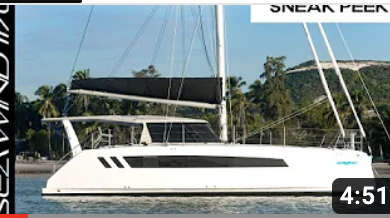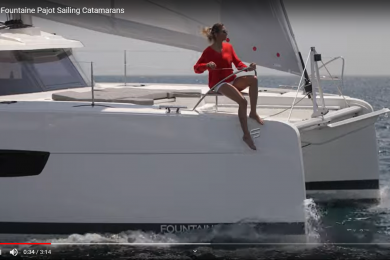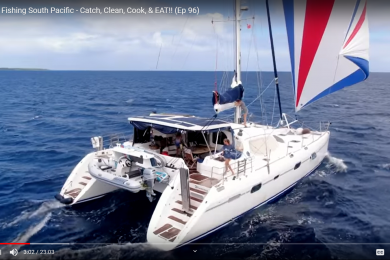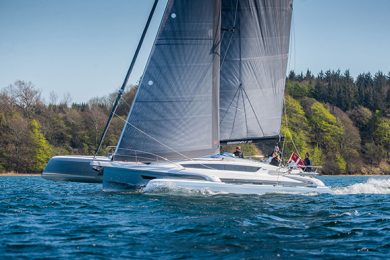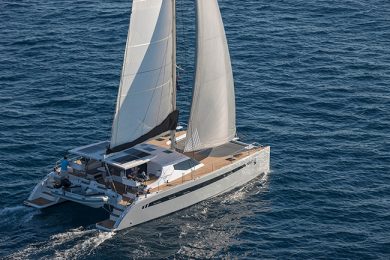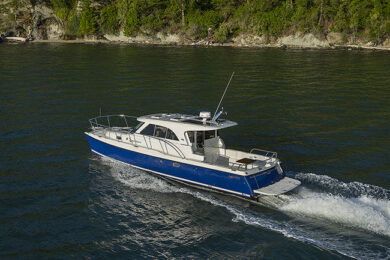Which is best for me? (Published Fall 2015)
Many buyers who contact us these days develop some very strong personal preferences about a range of things: centerboards versus keels, Yanmar versus Volvo, flybridge versus bullkhead helms, etc. etc. Many buyers send us long “must have” lists.
One of the “must haves” we are getting from some buyers these days is: “straight shaft engines.” Either there is a builder or two out there touting them because that is what they happen to offer, or some forum or blog or owner group stating their superiority, but we see a bit of an uptick in people who think straight shafts are the only way to go. What is clear to me is that most of these catamaran purchasers do not fully understand the advantages and disadvantages of straight shafts over saildrives. Let me clear a few things up.
STRAIGHT SHAFT ADVANTAGES
- Currently nobody makes saildrives for engines much larger than 75 horse power. As such, on most production cruising cats over 50 feet you will only be able to get straight shafts.
- Straight shafts are relatively mechanically simple. You have a shaft coming directly off the back of the engine that runs through a seal and then to a cutlass bearing and out into the water.
- Straight shafts are generally cheaper and easier to repair than saildrives.
- Straight shafts force the designer and builder to place the engines farther forward in the boat and anytime you move weight toward the center you reduce pitching moment. Many racing multihulls carry their engines in the very center of their hulls for this reason.
STRAIGHT SHAFT DISADVANTAGES
- Straight shafts require precision engine alignment and tend to put much more pressure on engine mounts. Engines often need to be realigned.
- Straight shafts are always louder and produce more vibration than saildrives. In larger cats with long sterns and space the engines and shafts can remain aft of the sleeping quarters in separate sound insulated compartments. On smaller cats this is generally not the case.
- Straight shafts produce less effective horsepower at the prop because the prop is at an angle. On a typical 40 foot horse power engine you lose three to four horse power over a cat with saildrives.
- The less the prop is angled down the better the performance on a straight shaft. That usually means positioning the engines quite forward of the sterns. This in-turn produces the enormous negatives of having to house the engines under the aft bunks, or a portion of them in most cats under 50 feet in length. This amounts to: more noise inside the living spaces, more vibration, more heat, and a potential for engine exhaust to encroach on the yacht’s interior. It also makes it a bit more difficult to properly ventilate the engine rooms.
- Sleeping close to or over the top of a running engine, especially a straight shaft, is noisy and hot.
- Most shaft seals are supposedly “dripless,” but anyone who has spent time around them knows that when the dripless seal starts to drip you had better take care of it fast. I have seen plenty of flooded engine rooms in my years on straight shaft cats. Both seals and cutlass bearings are therefore best replaced every two to three years. Straight shafts, in short, are not maintenance free.
SAIL DRIVE ADVANTAGES
- Saildrives are very quiet.
- Exact engine alignment is not critical.
- Saildrives can be positioned further aft in cats with ease and therefore make it possible to keep the engines out of the aft staterooms and in their own watertight engine rooms. On cats under 50 feet the design trend today is to produce sharper bows and wider, flared sterns aft, both to manage the engine weight aft and to get the cat to sit back on her haunches and pierce through waves to dampen pitching moment. A good example of this is the evolution of the Leopard 47 (a straight shaft boat) to the far superior sailing Morrelli and Melvin designed Leopard 46 (a saildrive boat.)
- Saildrives offer more horsepower at the prop.
SAIL DRIVE DISADVANTAGES
- Saildrives generally cost more to replace than shafts. The typical drive leg for a 40 to 50 foot cat is between $3,500 and $5,000 dollars.
- Saildrive legs must always have good zinc protection or there is a danger of the shaft corroding. Sloppy zinc inspections can lead to the destruction of saildrive legs. I’ve seen plenty of this at surveys from sloppy owner care.
- Saildrives carry seals that are meant to prevent salt water incursion into the lubricated shaft leg. If the seals are compromised salt water can enter the drive leg and lead to internal corrosion. Note: water incursion in a drive leg is easily seen if one inspects the saildrive fluid level and finds milky looking oil. Most prudent sailors replace their saildrive seals at least every other haul out. If they see milky fluid they change the fluid right away and then replace the seals at the next haul out. (The newer drives allow you to change the oil from inside the engine room easily, without having to haul the boat.) When a sailor finds milky fluid on the older saildrive legs it is good to run the engines and transmissions frequently. This will keep the saildrive oil emulsified until the next haul when the seals can be replaced.
- Some older saildrives had cone clutch or shifting problems. These were sometimes found on Yanmar SD 50 drive legs. That problem has been overcome with the new generation drives.
I have heard some internet chatter that straight shafts are better if you run aground, but I strongly disagree. If you run aground hard with shafts or saildrives and for any reason they are not protected by a keel, or mini keels, or a skeg, you are going to have a bit of a mess on your hands. One of the reasons I much prefer engines in their own watertight engine rooms is that if one does run aground and water enters the engine room from a broken shaft or saildrive leg, the water remains in the engine room, never entering the living quarters where water damage leads to major floor and woodwork repair in general.
The upshot of all this: Getting hung up on shafts or saildrives as a major purchasing concern is quite unwarranted. If having a shaft is something you are so convinced you must have, bear in mind you will live with all the advantages as well as the disadvantages noted above. More importantly, you will learn very quickly when you start to shop for a cat that 95 percent of the builders have all concluded that the advantages of saildrives far outweigh their disadvantages on cats below 50 feet and are therefore superior for use in the smaller modern catamaran. I happen to agree.
Phil Berman is the owner of The Mulitihull Company and manages the sale of over 75 used catamarans a year globally. He has attended hundreds of surveys and overseen the repair of a wide range of catamarans.
